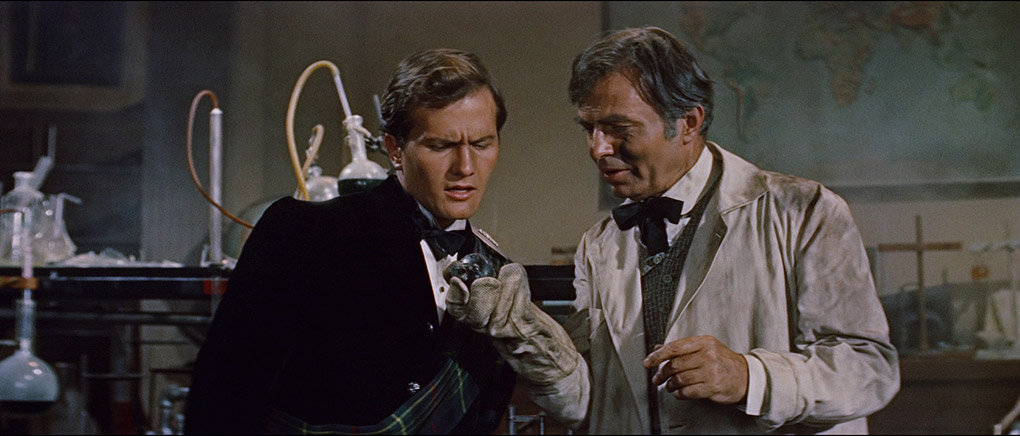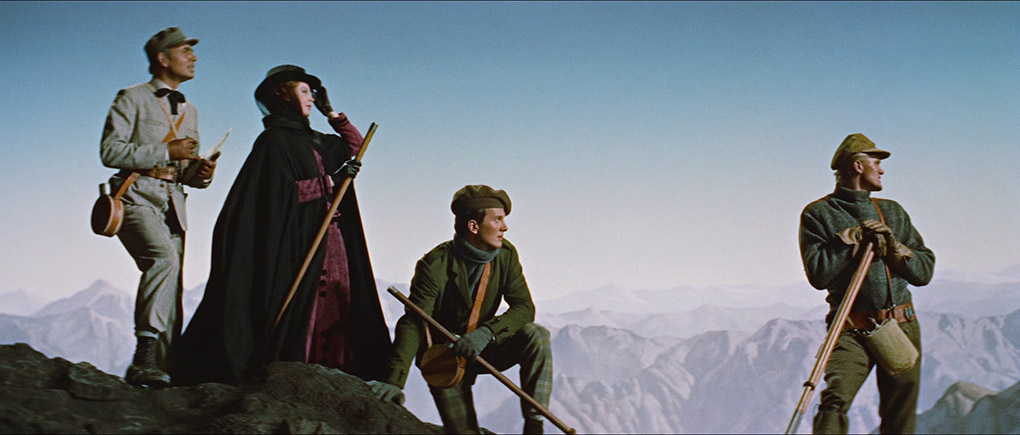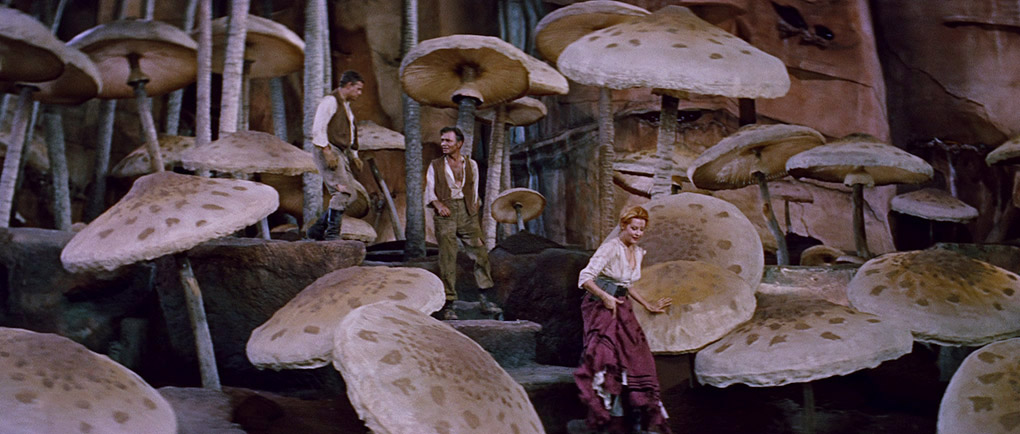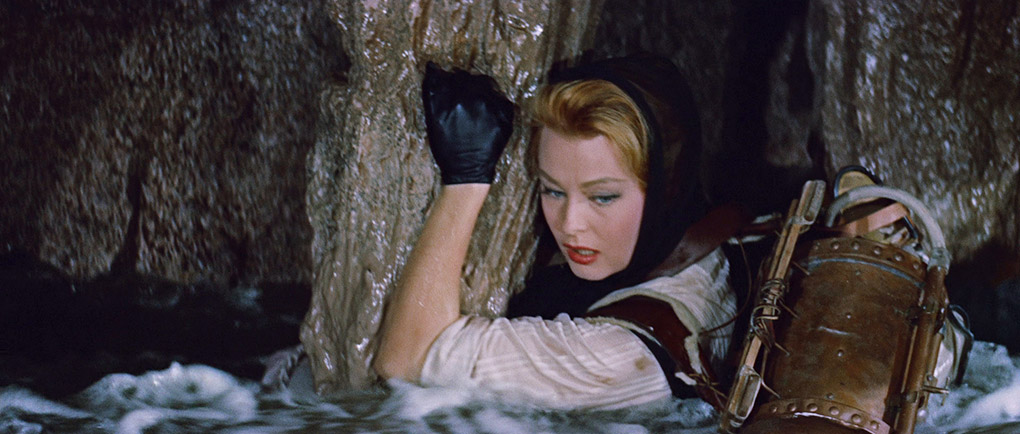|
Back in 1954, Disney inadvertently set a template for future film adaptations of novels by celebrated science fiction author Jules Verne when 20,000 Leagues Under the Sea became one of the biggest box-office hits of the year. It was a lavish production for a genre film of its day, but one targeted very much at the family audience, hence the inclusion of a comical animal sidekick (a sea lion named Esmerelda) and the still peculiar sight and sound of Kirk Douglas strumming a guitar and singing a song titled A Whale of a Tale. But the production design is gorgeous, the effects and aquatic photography impressive, and it all builds to a spectacular battle with a giant squid. Five years later, 20th Century Fox produced their own big budget Jules Verne adaptation in the shape of Journey to the Center of the Earth (being a Hollywood studio production, it is saddled with the American spelling of the word "centre"), which also pauses for a song, sports an amusing animal sidekick (a duck named Gertrude), and boasts eye-popping production design and a battle with oversized monsters. It even recasts the earlier film's star, James Mason, as another scientific obsessive, albeit this time on the theoretically right side of the moral divide.
The story kicks off in Edinburgh in 1880, where university professor Sir Oliver Lindenbrook's recent knighthood so delights his students that they embarrass him with the sort of rah-rah-rah song that you'd usually never hear outside of the walls of an exclusive public school. To mark the occasion, he is presented with a lump of volcanic lava by Alec McEwan, a devoted student who is also secretly courting Lindenbrook's daughter Jenny. Something about the weight of the lava intrigues Sir Oliver, and an explosively misfired experiment reveals that encased within it is an artefact belonging to an Icelandic scientist named Arne Saknussemm, who disappeared 300 years earlier after reputedly discovering a route to the centre (oh sorry, center) of the earth. The artefact also bears an inscription that, when translated, reveals that the entrance to the route in question sits within an extinct Icelandic volcano. Keen to act on his discovery, Lindenbrook contacts the eminent Professor Goteborg in Stockholm for verification of his findings, but when it becomes clear that Goteborg has used the information to launch his own expedition, Lindenbrook and Alec make their way to Iceland with the aim of beating him to this uncertain goal.

One of the unexpected pleasures of this particular film adaptation of Journey to the Center of the Earth is that it spends so long on the build-up to the titular expedition. We're almost 50 minutes in before Lindenbrook's party begins its descent into the volcanic crater, by when we've had a song, a betrayal, a kidnapping and a murder, and the Lindenbrook party has expanded to include the murdered man's headstrong widow, Carla, and buff, good-hearted local boy Hans and his pet duck Gertrude, all of whom we've been given time to get to know and like. I could happily have lived without the icky love song and the laboured gag in which the befuddled Lindenbrook and Alec attempt to read Morse code messages into the tapping of the unseen Gertrude's beak, and Mason and Boone's Scottish accents tend to come and go with the wind, but otherwise this proves hugely entertaining stuff, peppered with twists and propelled forward by director Henry Levin at the sort of spanking pace that was once the hallmark of just about every rollicking adventure tale.
It's once the party heads underground that the story moves into the realms of fantasy, though science is always on hand to explain away our incredulity with varying degrees of plausibility. It seems unlikely, for instance, that the phosphorous deposits on the rocks that line the lower levels of the journey would provide the sort of light in which the party is consistently bathed, but the wind-up lamps struck me as completely credible technology – I have just such a torch in my possession and it works a treat. The passing of time is so invisible that you only realise how long the party has been underground via almost offhand snippets of conversation, which does raise questions about how these four managed to cram what was likely a year's worth of provisions into their knapsacks, and just how the air they so effortlessly inhale is making its way down to caves located many miles below the planet's surface.

Frankly, I couldn't care less. Fantasy adventures such as this do not take place in the real world but in a creatively imagined alternate reality, one where dinosaurs thrive deep beneath the earth's crust and the planetary core is not a tightly compressed ball of molten rock but an expansive ocean with a whirlpool at its centre. Unconstrained by the shackles of scientific reality, art directors Franz Bachelin, Herman A. Blumenthal and Lyle R. Wheeler create a visually striking underground world, from the twisted and interconnecting trunks the salt pit into which Alec tumbles to the forest of giant mushrooms whose heads offer a welcome change of diet for the party and whose stalks are strong enough to be cut down and lashed into a seaworthy raft. A level of conflict is provided by the introduction of rival explorer, Count Saknussemm, a direct descendent of the man whose discovery led Lindenbrook to Iceland in the first place, though an edge of urgency is shaved from their shared determination to be the first to reach the Earth's core by a lack of a specific goal to the expedition beyond the famous reason given by George Mallory for climbing Everest, "because it's there."
James Mason is in commanding form as Lindenbrook, and while it did feel as if I'd had an "Aha!" moment stolen from me, I was still rather chuffed that in his on-disc evaluation of the film, Kim Newman shared my opinion that there was more than a whiff of Arthur Conan-Doyle's Professor Challenger about Lindenbrook's brusque manner and archaic sexism. This is nicely counterbalanced by Arlene Dahl's self-confident Carla, a woman smart enough to parry any of Lindenbrook's jibes but whose feminine allure at one point even prompts Alec to momentarily forget that he has pledged his love to another. As Alec, singer Pat Boone does a serviceable job ("The best that can be said of Pat Boone in this film," Kim Newman observes in his interview, "is that he's cheerful"), though if the producers hadn't been so determined to get him on board we might have been spared the musical interludes (word has it that there were originally more, but they were cut due to their effect on the pacing and I'm well aware that others find them rather charming). Even he can't be held responsible for the downright peculiar moment when, on discovering the forest of giant mushrooms, Lindenbrook suddenly breaks out in a jig in which he is promptly joined by his companions, making me wonder just what sort of mushrooms these actually were. Completing the party is Icelandic college athlete Peter Ronson as the utterly decent and dependable Hans, who delivers almost every line in his native tongue and for me is the most likeable character in the film – every time disaster struck, I found myself wincing at the prospect that he, as a secondary character, might be sacrificed and drop out of the story. When, late in the film, a genuinely shocking transgression is committed against him by the glumly unemotional Saknussemm (an enjoyable humourless turn from Thayer David), I was willing Hans to throttle him and rip off his limbs by way of retribution.

Journey to the Center of the Earth really is a fantasy adventure with something for everyone (except, perhaps, those with an aversion for fantasy adventures). It has more than enough plot and character scenes to justify its two-hour plus running time, is consistently entertaining and often rather fun, and its production design and effects have stood the test of time better than I could ever have hoped. Even the old trick of creating dinosaurs by sticking fins on the backs of iguanas and shooting them up close at a slower speed is nowhere near as ropey as I seem to recall it looking, though animal lovers might get a little twitchy about what happens to one of them in defence of the fictional human characters. The wondrous nature of the underground locations is enhanced by Leo Tover's handsome scope cinematography, and a palpable air of menace is created by the sinister bass notes of Bernard Herrmann's wonderfully expressive score. And you won't have to look far to spot its influence on later works, from the fins-on-lizards approach to creating screen monsters borrowed by Irwin Allen for his 1960 adaptation of Arthur Conan Doyle's The Lost World, to two notable sequences – one involving a beam of sunlight that reveals a secret entrance, the other the threat posed by a huge rolling boulder – that directly prefigure key sequences from Raiders of the Lost Ark.
Sourced from what Eureka in their press release claim is a "definitive" 4K restoration, the 2.35:1 transfer here is in terrific shape, boasting the sort of vibrant colour reproduction that feels almost designed to show off the handsome production design, while the impressively balanced contrast retains crucial detail even when the light levels drop (though in tradition of older Hollywood movies, it never drops too far, even in theoretically darker caverns). Although the odd shot is not quite as crisp as those that surround it, the sharpness and level of detail are generally excellent. All traces of dust and damage have been cleaned up, and the image sits solidly in frame throughout.

Journey to the Center of the Earth was originally screened with a 4-track stereo soundtrack, which has been reproduced here as a DTS-HD Master Audio 5.1 track. A Linear PCM stereo 2.0 track has also been included. Both are in fine shape, with the surround track having the edge in the way is spreads the music and the odd ambient sound around the room, though the action remains confined primarily to the front speakers. Bernard Herrmann's music sounds terrific on both tracks. You can also listen to Herrmann's music uninterrupted by dialogue, though sometimes accompanied by sound effects, on the isolated LPCM music and effects track.
Optional English subtitles for the deaf and hearing impaired are available.
Audio Commentary
The by now familiar duo of Bernard Herrmann biographer Steven C. Smith and film historian Nick Redman are joined by actress Diane Baker, who plays Jenny in Journey to the Center of the Earth and should be familiar to horror devotees for her small but memorable role as Senator Ruth Martin in The Silence of the Lambs ("Love the suit!"). Although not on screen for a good part of the film, Baker has plenty of enthralling memories of the production and her collaborators both in front of and behind the camera, and is ably fed by an enthusiastic and knowledgeable Steven Smith, with intermittent but well-timed prompts from Redman. Unsurprisingly and usefully, Smith also provides a good deal of information on Bernard Herrmann, his career and his specific contribution to this film. A hugely enjoyable extra that I gather has been licenced from the US Twilight Time Blu-ray release.

Interview with Kim Newman (22:06)
Genre writer Kim Newman delivers a typically thorough and entertaining evaluation of the film, in the process also touching on other Jules Verne film adaptations of the period. Topics covered include director Henry Levin, producer and co-writer Charles Brackett, how the film embellishes the thinly defined characters and plotting of Verne's novel, the cast, the monsters, the trend of putting pop stars in movies to target a wider demographic, and more.
Restoration Featurette (3:47)
Previous restorations of the film are run side-by-side with their source material to show the progression from the worn and faded condition of the original camera negative to the pristine transfer on this Blu-ray.
Original Theatrical Trailer (3:21)
There are a few spoilers in this cheerfully old-school sell narrated by James Mason, who reveals it was "filmed in the incomparable magic of CinemaScope."
Also included with the release disc is a booklet featuring an original review of the film from 1959; a poster gallery; and a selection of rare archival imagery, but this was not available for review.
A lively and consistently entertaining fantasy adventure with well-defined characters, enjoyably episodic storytelling, a sly sense of humour and sometimes sumptuous visuals. It's directed and performed with just the right degree of gusto and looks lovelier than you've likely ever seen it on Eureka's new Blu-ray, which also sports a couple of first-class extras. Warmly recommended.
|